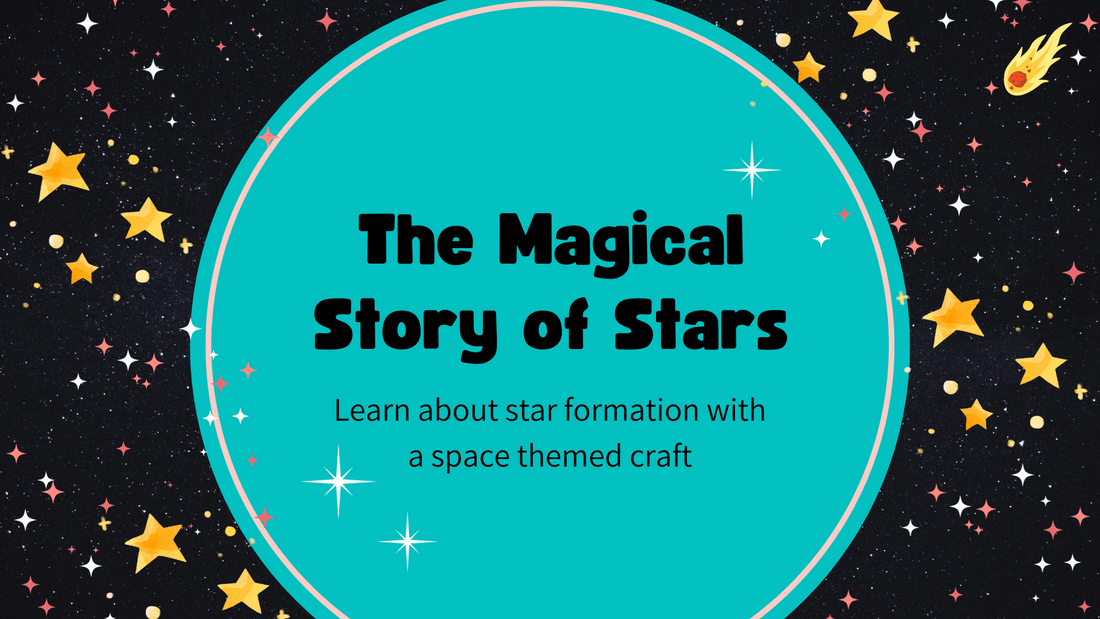When you look up at the night sky, what do you see?
Thousands of bright and beautiful stars.
Take a look at the stars with your very own DIY telescope that you can make from my freebie: Explore the Universe with these Exciting Space Crafts for Kids.
When you’re in the city, you may see less stars than when you’re in the country or wilderness, but this doesn’t mean they’re not there. They are just harder to see with all the lights from the city
But did you know that the stars you see today were actually formed thousands of years ago?
That’s exactly what we’re going to learn about in this blog post.
Not only do stars look beautiful, but they are some of the most important building blocks of galaxies. They also make and distribute elements like oxygen and carbon.
From Dust to a Protostar
Stars form from an accumulation of dust and gas. This process, from the initial gas cloud, to a bright and shining star like the sun, takes millions of years. Any leftover material from the formation of the star is then used to create planets and other objects that orbit around that star.
FUN FACT: The sun is the only star in our solar system and is over 4.5 billion years old! All the other stars you can see are part of the Milky Way Galaxy. Our solar system has only one star (the sun), but more than half of all stars are in solar systems with other stars. Imagine having two (or more) suns in the sky!

The Milky Way Galaxy
In space, there are giant clouds of gas and dust - these are called nebulae. These nebulae fill the spaces between galaxies. Nothing much happens in them, they are cold and stable, UNTIL something arrives to break up the monotony.
This could be a comet or a shockwave from a supernova (which forms when a star has reached the end of its life and explodes) or even just a collision with another cloud.
This disturbance triggers star formation as it disrupts the gas and dust and makes the nebula active. The particles inside the nebula start to collide. When they collide, the particles stick together. Some areas in the nebula now have a lot more matter than other regions.
As these clumps of matter accumulate more and more particles, they grow in mass until they are big enough to produce their own gravity. Because of this gravity, the clump start to pull in even more particles with its gravitational pull.

A Nebula
Eventually this clump of particles gets so big it begins to collapse under its own weight. This occurs over millions of years. The center of the clump gets very hot and is now known as a protostar.
A protostar is a developing star that isn’t hot enough to do nuclear fusion.
Nuclear fusion is when two light atoms fuse together to form a heavier atom. In the case of stars, hydrogen atoms fuse and produce helium atoms.
From Protostar to a Star
Over time, the protostar draws in more and more material and continues to heat up until it reaches a tipping point. When the star reaches 7,000,000 Kelvin (that’s 12,600,000 Fahrenheit!), it is able to start the process of nuclear fusion. This means that the hydrogen atoms fuse to produce helium atoms.
The nuclear fusion reaction produces energy. Massive gas jets erupt which clear away any remaining gas and dust that is not a part of the protostar.
Eventually, the inwards force of gravity is exactly balanced by the outwards force of energy and the protostar reaches a stable state. The protostar has now become a star.
The Life Cycle of Stars
The larger the star is, the shorter its lifespan will be. However, for most stars this is still billions of years. Only the most massive of stars have life cycles less than this.
To put it into perspective, the sun is a medium sized star. There are stars that are 100x bigger in diameter than our sun. For stars like our sun, it takes about 50 million years to reach the main star phase. Once in this phase, it will stay burning for around 10 billion years.

A space view of the Earth and the Sun
Now that you know all about how stars are formed, you will look at them a bit differently I’m sure. Don’t forget you can make your very own DIY telescope to see the stars more clearly using my freebie: Explore the Universe with these Exciting Space Crafts for Kids.
References:
- NASA
https://science.nasa.gov/astrophysics/focus-areas/how-do-stars-form-and-evolve/
https://spaceplace.nasa.gov/sun-compare/en/
- How Stuff Works
https://science.howstuffworks.com/how-are-stars-formed.htm
- Frontiers for Young Minds
https://kids.frontiersin.org/articles/10.3389/frym.2019.00092






